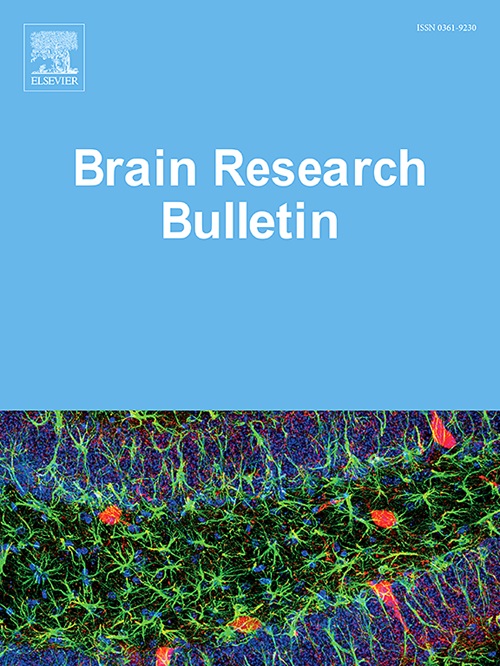氨基乙酸对慢性酒精中毒患者学习记忆功能及神经化学变化的影响。
IF 3.5
3区 医学
Q2 NEUROSCIENCES
引用次数: 0
摘要
目的:本研究旨在探讨氨基乙酸(AOAA)对慢性酒精中毒大鼠模型的认知功能,特别是学习和记忆的影响。此外,该研究还探索了前额皮质中胱硫氨酸β-合成酶(CBS)、硫化氢(H₂S)和血清素(5-HT)水平的变化,以了解潜在的神经化学机制。方法:雄性SD大鼠64只,随机分为Con、Con + AOAA、Model、Model + AOAA 4组,每组16只。模型组灌胃6%乙醇溶液28 d。从第14天起,模型+ AOAA组小鼠每天腹腔注射AOAA (5mg/kg),连续14 d。通过Morris水迷宫评估认知功能,通过atp酶活性评估线粒体功能,并测量H₂S水平。免疫组化分析前额皮质CBS和5-羟色胺水平。结果:与对照组相比,模型组大鼠的学习记忆功能明显受损,CBS表达增加,H₂S水平升高,5-HT释放减少。AOAA治疗改善了记忆性能,降低了CBS表达和H₂S水平,增加了5-HT释放,尽管这些指标并未完全恢复到基线水平。两组间无明显差异。结论:AOAA可能通过抑制CBS表达、降低H₂S水平和增强前额皮质5-HT释放来缓解慢性酒精中毒相关的认知缺陷。这些发现表明AOAA是一种潜在的治疗酒精引起的认知障碍的策略。本文章由计算机程序翻译,如有差异,请以英文原文为准。
Effects of aminooxyacetic acid on learning and memory function and neurochemical changes in chronic alcoholism
Objective
This study aimed to investigate the effect of aminooxyacetic acid (AOAA) on cognitive function, particularly learning and memory, in a rat model of chronic alcoholism. Additionally, the study explored changes in cystathionine β-synthase (CBS), hydrogen sulfide (H₂S), and serotonin (5-HT) levels in the prefrontal cortex to understand the potential neurochemical mechanisms involved.
Methods
Sixty-four male SD rats were randomly divided into four groups, with 16 rats in each: Con, Con + AOAA, Model, and Model + AOAA. The Model group received a 6 % ethanol solution for 28 days. From day 14, the Model + AOAA group was treated with daily intraperitoneal injections of AOAA (5 mg/kg) for 14 consecutive days. Cognitive function was assessed using the Morris water maze, mitochondrial function was evaluated through ATPase activity, and H₂S levels were measured. CBS and 5-HT levels in the prefrontal cortex were analyzed by immunohistochemistry.
Results
Compared to the control groups, rats in the Model group exhibited significant impairments in learning and memory, increased CBS expression, elevated H₂S levels, and decreased 5-HT release. AOAA treatment improved memory performance, reduced CBS expression and H₂S levels, and increased 5-HT release, although these measures did not fully return to baseline. No significant differences were observed between the two control groups.
Conclusion
AOAA may alleviate cognitive deficits associated with chronic alcoholism by inhibiting CBS expression, reducing H₂S levels, and enhancing 5-HT release in the prefrontal cortex. These findings suggest AOAA as a potential therapeutic strategy for alcohol-induced cognitive impairments.
求助全文
通过发布文献求助,成功后即可免费获取论文全文。
去求助
来源期刊

Brain Research Bulletin
医学-神经科学
CiteScore
6.90
自引率
2.60%
发文量
253
审稿时长
67 days
期刊介绍:
The Brain Research Bulletin (BRB) aims to publish novel work that advances our knowledge of molecular and cellular mechanisms that underlie neural network properties associated with behavior, cognition and other brain functions during neurodevelopment and in the adult. Although clinical research is out of the Journal''s scope, the BRB also aims to publish translation research that provides insight into biological mechanisms and processes associated with neurodegeneration mechanisms, neurological diseases and neuropsychiatric disorders. The Journal is especially interested in research using novel methodologies, such as optogenetics, multielectrode array recordings and life imaging in wild-type and genetically-modified animal models, with the goal to advance our understanding of how neurons, glia and networks function in vivo.
 求助内容:
求助内容: 应助结果提醒方式:
应助结果提醒方式:


